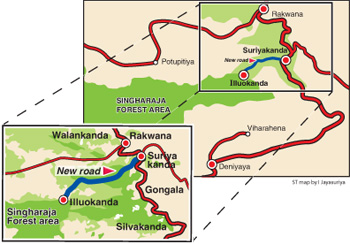Roads that are being constructed across many wildlife sanctuaries in the name of development are in the news these days. The latest among these is a road that will be constructed adjacent to the World Heritage Site of the Sinharaja Rainforest. The proposed road will connect Pothupitiya/ Illuokanda to Rakwana/Deniyaya A17 road near Suriyakanda.
 Tagged as a major project to connect Kalawana and Kolonne, local politicians are promising the people of the area that the road would bring much relief to them. However, this road, work on which began on July 27, will be harmful to the rich biodiversity in the area, environmentalists warn. Tagged as a major project to connect Kalawana and Kolonne, local politicians are promising the people of the area that the road would bring much relief to them. However, this road, work on which began on July 27, will be harmful to the rich biodiversity in the area, environmentalists warn.
The proposed road will mainly go through lands adjacent to the Morning Side of Sinharaja , say conservationists attached to the Green Movement of Sri Lanka. Most of the forest lands which are under the Land Reform Commission (LRC) will be cleared for this road and the next inevitable step would be the distribution of LRC lands in the vicinity of the road to private owners, Green Movement’s Bandu Ranga Kariyawasam said.
He claimed a considerable area of forest patch is to be cleared under this project, although the Central Environmental Authority had not carried out an Environmental Impact Assessment (EIA) and the Forest Department too seemed to be silent on the issue.
Environmental Lawyer Jagath Gunawardane stressed that any development even close to 100 metres was not legal. He said there was a possibility that this road would cut across protected areas too, adding that authorities should investigate the matter.
Sinharaja was declared a UNESCO World Heritage Site and a Man and Biosphere Reserve (MAB) due to its unique biodiversity.
The Morning Side of Sinharaja has a unique ecosystem and is the only home for many of the threatened endemic animals and plants including several amphibian species that have been recorded only on one single location. These sites are sometimes outside the protected areas either on private lands or LRC lands. This highlights that there could be many more undiscovered species new to science on the adjacent forest patches to Sinharaja and other rainforests and clearance of a small patch of forest could make a species extinct within a few days. Even if this road results in the clearing of rainforest patches outside the boundary of the protected area it would still make a big impact.
Sri Lanka has been tagged as one of the 35 Biodiversity Hotspots of the world considering the number of species present in a unique land area, especially in tropical rainforests and cloud forests. Although these rainforests do not have charismatic species like elephant or bear, they are home to endemic lizards, amphibians, plants, freshwater fish, birds etc. The clearance of such a forest in this area is 10 times more destructive than clearing of a forest in a dry zone. But 80% of Sri Lanka’s Protected Areas are located in the dry zone and the wet zone which results in forests in the hill country being encroached for different reasons.
Environmentalists also say the conservation of these tropical rainforests is linked to the conservation of natural forest cover and this is emphasized in the 1997 report “Designing an Optimum Protected Area System for Sri Lanka” which has been collectively prepared by IUCN and the World Conservation Monitoring Centre (WCMC). It recommends Sinharaja Forest Reserve be conserved as a contiguous forest. This means adding LRC forest lands too to the protected area. But even after 11 years, this has not been implemented resulting in fragmentation and deforestation of the forest.
Mr. Gunawardane also pointed out that a cabinet paper was approved in 2004 to handover LRC lands adjacent to the Sinharaja to the Forest Department when A.H.M.Fowzie was the environmental minister. The Green Movement also says that the cabinet paper instructed to value these lands Rs.0/= (Zero value) and give them to the Forest Department. But LRC has valued these lands, claiming money from the Forest Department and Forest Department apparently had no funds to get these lands back. Due to these ongoing disputes valuable rainforest patches in these LRC lands are under threat.
The cultivation of tea and vegetables is a major reason for encroachment into forest land in these areas and the proposed road will entice more people to encroach, warn environmentalists. In a move to exert pressure on authorities to take steps the Green Movement has written to UNESCO seeking that Sinharaja be named a ‘World Heritage in Danger’ which would give more protective measures. |

 Tagged as a major project to connect Kalawana and Kolonne, local politicians are promising the people of the area that the road would bring much relief to them. However, this road, work on which began on July 27, will be harmful to the rich biodiversity in the area, environmentalists warn.
Tagged as a major project to connect Kalawana and Kolonne, local politicians are promising the people of the area that the road would bring much relief to them. However, this road, work on which began on July 27, will be harmful to the rich biodiversity in the area, environmentalists warn.